PLATE TECTONICS-Unit#3
Objectives and Indicators for this Unit
C. PLATE TECTONICS
INDICATOR
- 1. Recognize and describe the internal and external structure of the Earth.
OBJECTIVES
- Recognize and describe that the Earth's mantle
- Recognize and describe that the Earth's core
- Is at the center of the Earth
- Is very hot
- Is dense and metallic
- Identify and describe the Earth's crust.
- The solid crust consists of separate plates
- The plates constantly move in different directions due to convection currents
- The plates interact with one another as a result of plate motion.
INDICATOR
- 2. Recognize and explain how major geologic events are a result of the movement of Earth's crustal plates.
OBJECTIVES
- Recognize and describe the evidence for plate movement.
- Shape of continents
- Continuity of geologic features and fossils on the continents
- Ocean rifts, seafloor spreading
- Global patterns of earthquakes and volcanoes
- Recognize and explain that major geologic events (earthquakes, volcanic activity, sea floor spreading) occur along crustal plate boundaries.
Vocabulary Words to look up and write in your journalInner coreOuter coreMantleCrustLithosphereAsthenosphereTectonic platePangaeaMid- ocean ridgesSeafloor spreadingOcean trenchesConvectionConvection currentDivergent boundaryConvergent boundaryTransform boundaryRift valleyFaultEarthquakeSubductionContinentVolcanoMagmaLava
ASSIGNMENT=
Please copy this quiz in your journal and ANSWER the questions there
ASSIGNMENT=
Please copy this quiz in your journal and ANSWER the questions there
ASSIGNMENT=
Please copy this quiz in your journal and ANSWER the questions there
ASSIGNMENT=
ASSIGNMENT=
ASSIGNMENT=
§ What are the layers of the Earth?
§ What was Pangaea?
§ What is the Theory of Plate Tectonics?
§ What is the evidence for plate movement?
§ What causes plates to move?
§ What happens/forms when continental plates move?
§ What is an earthquake? How does is form?
§ What is a volcano? How does is form?
§ Why do earthquakes and volcanic eruptions occur?
ASSIGNMENT=
Please copy this quiz in your journal and fill in the blanks there
ASSIGNMENT=
Please copy this quiz in your journal and fill in the blanks there
ASSIGNMENT=
Please copy this quiz in your journal and fill in the blanks there
ASSIGNMENT=
ASSIGNMENT=
ASSIGNMENT=
|
| ||||
|
| ||||
|
| ||||
|
PRE-TEST Plate Tectonics Theory
|
| ||||
|
|
The Earth A Living Planet
Assignment= Please watch this video and take 20-25 notes from it
Read this article . . .
The Earth
Earth is a living planet. Activity is constantly taking place not only on the surface, but also on the inside beneath our feet. We do not know exactly how our planet works. Compared to the age of the universe, the amount of time we have studied the Earth is very short. We do have theories about how continents form and change, but the scope of testing such theories is far too broad to be realistic. We continue to study evidence, but are not able to prove any theories beyond a doubt.
Assignment=Please copy this graphic organizer and complete it in your journal from the reading above.
Assignment= Please explain in your journal what the expression, "
Earth is a living planet" means.
Geophysicist
The coastlines of Africa and South America fit together like pieces of a jigsaw puzzle. This is one of many pieces of evidence to support the theory of continental drift.
Throughout history, several theories have tried to explain the behavior and evolution of the Earth. The most convincing of these, widely supported by scientists, is the plate tectonics theory.
Assignment=Please copy this graphic organizer and complete it in your journal from the reading above.
Click on the image to see an animated history of the earth from 600,000,000 years ago to 200,000,000 years into the future. |
Alfred Wegener, a German geologist and meteorologist, studied the close fit between the coastlines of Africa and South America. He observed that fossils were similar on both sides of the Atlantic. In 1912, he proposed the theory of continental drift. According to his theory, the two continents were once joined together.
Over the following years, the theory of continental drift was refined to become the theory of plate tectonics. Scientists studied how plant and animal fossils are spread throughout the world. They learned more about the nature of the ocean floor and distribution of volcanoes and earthquakes. They gained new information about Earth’s ancient magnetism and the flow of heat from the interior of the Earth.
Assignment=Please copy this graphic organizer and complete it in your journal from the reading above.
Assignment= Explain in your journal what has been learned by the plate tectonics theory that you read in the paragraphs above?
he Earth — A Living PlanetBeneath the Surface
At the surface of the Earth, earthquakes and volcanoes give evidence of action taking place inside the planet. The plate tectonic theory explains these events, as well as the distribution of certain types and ages of rocks.
We are able to drill only a few kilometers into the ground. This is nowhere near deep enough to give us proof about the inner composition of our planet. However, we are able to get strong clues from seismology (the study of earthquakes) and seismics (the study of man-made waves).
- The crust is a relatively thin layer around the outside of the Earth. It is about six to seven kilometers thick under the oceans, and it ranges from 12 to 60 kilometers thick beneath the continents. Like the shell of an egg, the Earth’s crust is brittle and can break.
- The mantle is about 2900 kilometers thick and is made mostly of melted rock.
- The core is made of two layers: an outer core of melted rock and an inner core of solid rock.
Assignment=Please copy this graphic organizer and complete it in your journal from the reading above.
Assignment= In your journal, please explain what the crust, the mantle, and the core are.
The Earth’s crust overall is heterogeneous — that is, its composition changes depending upon the location. However, the crust under the oceans is homogeneous, composed entirely of basalts, and very magnetic. The rocks beneath the ocean have an average age of less than 20 million years. The oldest oceanic rocks are 117 million years old, which is still quite young in geological terms. Beneath the continents, the crust is heterogeneous, composed of many rocks (essentially granites) and not very magnetic. These rocks have an average age of 1 to 2 billion years, much older than the rocks beneath the oceans. The oldest known rocks are 3.8 billion years old.
Assignment=Please copy this graphic organizer and complete it in your journal from the reading above.
are.
 Courtesy USGS The earth is made of layers of rock and metal, some of which are molten. The crust on which we live is a thin, brittle layer, like the shell of an egg. |
The crust and the shallow part of the mantle together are called the lithosphere. The lithosphere is rigid and about 100 kilometers thick. It is able to move about on the asthenosphere, the hotter, liquid layer directly beneath it. According to the plate tectonic theory, the lithosphere is not one solid block, but rather several pieces called plates. The plates are not attached to each other. They can move and push against each other in an organized way. The crust is like a jigsaw puzzle. Each piece is different, but together they make a clear picture.
Assignment=Please copy this graphic organizer and complete it in your journal from the reading above.
What causes the plates to move?
 Courtesy USGS The movement of continental plates around the Earth is thought to be due to slow convection currents in the melted rocks of the mantle. |
The mantle is a very deep layer of melted rocks called magma. The outer layer of the mantle cools when it meets the colder, solid crust above it and exchanges energy. Meanwhile, the inner layer of the mantle is getting warmer by exchanging energy with the very hot core beneath it. The result of this difference in temperature is a movement called convection. According to the plate tectonics theory, the plates move as a result of the slow convection currents moving beneath them.
The convection currents move magma toward the surface. As they move, they drag along the plates. The density of hot rocks is less than the density of colder ones. The less dense hot rock can rise through the crust and form a magnetic plume reaching to the surface. This is how a volcanic eruption begins.
The Earth — A Living PlanetPlate Borders & Mountain-Building
Plates move in relation to each other in three different ways: moving apart (divergent), pushing together (convergent), and rubbing sideways (transform)
.
Assignment=Please copy this graphic organizer and complete it in your journal from the reading above.
Assignment= In your journal, please explain what
divergent , convergent, and transform are
Divergent Plate Boundary (above) — Plates moving apart, as at the mid-Atlantic ridge. Click to see animation of different types of plate boundaries. |
Convergent Plate Boundaries — Plates moving towards each other can create either mountains (above) or a subduction zone (below). Click to see animation of different types of plate boundaries |
Transform plate movement (below) — Plates moving sideways and rubbing against each other can cause major earthquakes. Click either image to see animation of different types of plate boundaries. |
Assignment= Please click and watch this video and take notes from it about
Divergent Plate Movement
Divergent Plate Movement
When plates move apart from each other, or diverge, it causes a weakness in the crust. This makes it possible for magma to come to the surface from below.
Imagine very hot rock coming up from below and arriving at the surface on the ocean floor. As it cools down, this lava creates new crust. This is what is happening at the mid-oceanic ridges. These ridges are actually chains of volcanoes running along the ocean floor. Sometimes the tops of the volcanoes rise above the surface of the ocean water to form an island such as Iceland.
Assignment=Please copy this graphic organizer and complete it in your journal from the reading above.
Ocean floor volcanoes produce rocks from the mantle. These rocks, called basalts, create new oceanic floor. This explains why the rocks at the bottom of the ocean are young compared to other rocks. The spreading rate of new ridges varies from place to place around the world. In some locations as much as 18 centimeters may be added per year. In other places there may be almost no growth at all.
The lavas produced under water at these ridges have a special name because of their shape. Because they are formed in water, they cool quickly while flowing down the side of the submarine volcano. They are called pillow lavasbecause the cooling basalt forms pillow-shaped lumps.
Although the spreading rate of the ridges is not very fast, it has been going on for millions of years. Imagine what would happen if no crust were destroyed — the Earth would grow bigger every day! Thankfully, there is a way to destroy crust.
Assignment=Please copy this graphic organizer and complete it in your journal from the reading above.
Convergent Plate Movement:
Subduction Zones
When plates move towards each other, or converge, crust is destroyed as one plate rides over the top of the other. Oceanic plates are heavier and thinner, so they are generally forced underneath the lighter, thicker continental plates. The area where such an event takes place is called a subduction zone.
Volcanoes are also found near subduction zones. When the cold oceanic crust is forced down under the edge of a continental plate, it is heated by the underlying hot mantle. The heating is hastened by friction as the plates move against each other, causing earthquakes.
Over millions of years, thick layers of sediment have been laid on top of the old basaltic ocean floor. These layers include sand and mud from rivers and fragments of shells from sea creatures. As the oceanic plates go beneath the continental plates, the sediments are dragged down to the mantle where they are heated. They melt to create a new kind of magmathat forms rocks called andesite, named after the Andes Mountains in South America — an example of a subduction zone. Andesitic magma often escapes through cracks to the surface, causing volcanic eruptions. The melting sediments contain a lot of cold seawater, so these eruptions can be very dangerous. They are often associated with the release of superheated steam and other gases that can cause violent explosions.
Assignment=Please copy this graphic organizer and complete it in your journal from the reading above.
Assignment= Please click and watch this video and take notes in your journal from it about mountain building
Convergent Plate Movement:
Mountain-Building
When plates move towards each other, rather than one sinking below the other, they may crumple into each other. The result is mountain-building. This is how the Himalayas were formed when the Indian subcontinent collided with Asia.
Transform Plate Movement
Transform plate movement takes place when two plates move sideways and rub against each other. The result is likely to be an earthquake. Transform plate movement is not associated with volcanoes or mountain-building. The San Andreas Fault in California, USA, is a site of this type of plate movement.
Assignment=Please copy this graphic organizer and complete it in your journal from the reading above.
Assignment=Explain about when
Transform plate movement happens (in your journal)
Plate Tectonics By Sharon Fabian |  |
1 The earth, just like a middle schooler sitting at his desk all afternoon, is restless! Even though we think of the earth as solid and steady under our feet, it is actually moving and shifting all the time. The scientific study of this earth movement is called plate tectonics. A plate is just a huge slab of rock, and tectonics comes from an old Greek word meaning "to build." So plate tectonics is the theory that explains how the earth's surface is built up from rocky plates which are moving. 2 This theory is fairly new - it began in the 1960s. But even before that, scientists had the idea that the earth was always shifting. In 1912, Alfred Wegener came up with a theory called "continental drift" which said that maybe the seven continents sort of floated around on the earth. Way back in 1596, a Dutch mapmaker named Abraham Ontelius noticed that it looked like America had been "torn away from Europe and Africa." Scientists thought that, at one time, all of the continents might have been just one huge continent. They called it the supercontinent, and named it Pangaea. It may have existed around 225 million years ago. If you take a world map and cut out the continents, you can try to piece them together like a puzzle to make Pangaea.
3 Scientists have learned much more about these moving plates since the 1960s by studying the boundaries where the plates bump together. Since many of these boundaries are under the ocean, they use modern technology to search for clues. Sonar has been used to find out how deep the ocean is in various areas. Satellites have mapped out the boundaries of the plates, and shown how they changed over time. Magnetic strips on the ocean floor have been discovered by scientists using magnetometers. 4 One really big discovery was the mid-ocean ridge. The mid-ocean ridge is a huge underwater mountain chain that zig-zags around some of the continents and circles much of the earth. The mid-ocean ridge has been built up from magma that pushes up from below. At the same time that magma is pushing up and causing the sea floor to spread in some places, in other places the sea floor is gradually disappearing down inside ocean floor trenches. 5 A part of the mid-ocean ridge, called the Mid-Atlantic Ridge, goes right through the middle of Iceland. It causes big splits called fissures, lots of volcanoes, and lava fountains. 6 Another example of spreading, or plates pulling apart, happened in northern Africa many years ago. There Saudi Arabia became separated from the rest of the continent of Africa as the plates spread apart. That is how the Red Sea was formed. When plates pull apart, forming new crust for the earth, they are called divergent plates. 7 Plates can also move toward each other. Then they are called convergent plates. Sometimes they crash together, sometimes one plate slowly slides under the other. 8 Sometimes the plates scrape together side by side. The San Andreas Fault, which runs down the middle of California, is an example of plates that are scraping along side by side. It is known as a transform fault. If you have heard people joking about California falling into the ocean, this is what they are talking about! Of course these things take time, often millions of years. 9 Altogether there are about 12 plates that make up the surface of the earth. Many of the continents have their own plate. For example there is a North American plate, which includes all of North America and extends out into the ocean on both sides. Europe and Asia share a plate, the Eurasian Plate. There are also plates that are mostly under the oceans. Plate tectonics show us powerful forces at work within the earth. These forces cause earthquakes to happen, volcanoes to erupt, and mountains to form. People cannot control these powerful forces, but we can learn a lot from them.
Copyright © 2011 edHelper
Assignment=Explain about Who
Abraham Ontelius
was
and what did he discover (in your journal)
ASSIGNMENT=
Please copy this quiz in your journal and fill in the blanks there
ASSIGNMENT=
Please copy this quiz in your journal and fill in the blanks there
ASSIGNMENT=
Please copy this quiz in your journal and fill in the blanks there
ASSIGNMENT=
ASSIGNMENT=
ASSIGNMENT=
|
| ||||
|
| ||||
|
| ||||
|
Plate Tectonics Theory By Cindy Grigg |  |
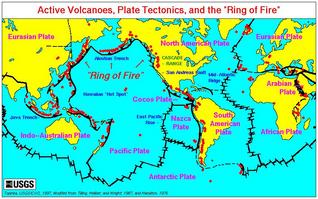 1 The earth's crust and the upper part of the mantle are known as the lithosphere. The lithosphere is solid and very firm, but it is not one whole piece. It is broken into sections called plates. There are eight major plates and some smaller ones. The places where these plates meet are called plate boundaries.
1 The earth's crust and the upper part of the mantle are known as the lithosphere. The lithosphere is solid and very firm, but it is not one whole piece. It is broken into sections called plates. There are eight major plates and some smaller ones. The places where these plates meet are called plate boundaries. Assignment=Please copy this graphic organizer and complete it in your journal from the reading above.
Assignment= Explain what a lithosphere is (in your journal)
lithosphere is (in your journal)
2 The plate tectonics theory explains how the continents drifted. It also explains how volcanoes, earthquakes, and mountains form. Plate tectonics is the study of the movement of Earth's crust. It's hard to imagine huge pieces of the earth's crust moving around, but they do. The movement is very small, though - only five to ten centimeters each year. What causes the plates to move? The simple answer is heat from inside the earth.
Assignment=Please copy this graphic organizer and complete it in your journal from the reading above.
3 Under the lithosphere lies the asthenosphere. It is part of the earth's mantle. It is still solid, but it is much less firm. Geologists (scientists who study the earth) say that it has plasticity. It is soft because it is almost, but not quite, melted. This is magma, and it can flow like thick syrup. Geologists believe that the earth's plates move about on the asthenosphere like bubbles in a pan of hot water. Heat causes the magma to rise up in the mantle. When the molten magma meets the rigid material of the lithosphere, it moves across the surface horizontally. The magma begins to cool and sinks back down into the mantle. The cycle repeats.
Assignment=Please copy this graphic organizer and complete it in your journal from the reading above.
4 The earth's landmasses and oceans sit on top of the tectonic plates. As the plates move, the oceans and continents ride on top of them. The plates move from side to side as well as up and down. The sides of plates may push together. They may pull away from each other. They may grind past each other in opposite directions. Over millions of years, the plates change in size and shape as the edges are added to, crash together, or pushed back into the mantle and melted.
Assignment=Please copy this graphic organizer and complete it in your journal from the reading above.
Assignment= Explain in your journal what happens to the earth's plates during millions of years
5 Where two plates crash together, mountains are pushed up. This is how the Himalaya Mountains formed about 70 million years ago. Volcanoes and earthquakes occur at plate boundaries, too. The movement of tectonic plates changes the surface of the earth. Plate movements affect people and animals living on earth.
Copyright © 2011 edHelper
ASSIGNMENT=
Please copy this quiz in your journal and fill in the blanks there
ASSIGNMENT=
Please copy this quiz in your journal and fill in the blanks there
ASSIGNMENT=
Please copy this quiz in your journal and fill in the blanks there
ASSIGNMENT=
Please copy this quiz in your journal and fill in the blanks there
ASSIGNMENT=
ASSIGNMENT=
ASSIGNMENT=
|
| ||||
|
|
Plate Tectonics Theory
Plate Tectonics Theory
Assignment= In your journal, w
rite a letter to a friend and explain how something as large and heavy as a whole continent can move around.Plate Tectonics Theory By Cindy Grigg |  |
ASSIGNMENT= Please copy this cloze assignment in your journal and fill in the blanks there
Directions: Fill in each blank with the word that best completes the reading comprehension.ASSIGNMENT= Please copy this cloze assignment in your journal and fill in the blanks there
 The earth's crust and the upper part of the mantle are known as the lithosphere. The(1) _______________________ is solid and very firm, but it is not one whole piece. It is broken into sections called plates. There are eight major plates and some smaller ones. The places where these plates meet are called plate boundaries.
The earth's crust and the upper part of the mantle are known as the lithosphere. The(1) _______________________ is solid and very firm, but it is not one whole piece. It is broken into sections called plates. There are eight major plates and some smaller ones. The places where these plates meet are called plate boundaries.The plate tectonics theory explains how the continents drifted. It also explains how volcanoes, earthquakes, and mountains form. Plate (2) _______________________ is the study of the movement of Earth's crust. It's hard to imagine huge pieces of the earth's crust moving around, but they do. The movement is very small, though - only five to ten centimeters each(3) _______________________ . What causes the plates to move? The simple answer is heat from inside the earth.
Under the lithosphere (4) _______________________ the (5) _______________________ . It is part of the earth's mantle. It is still solid, but it is much less firm. Geologists (scientists who study the earth) say that it has (6) _______________________ . It is soft because it is almost, but not quite, melted. This is magma, and it can flow like thick syrup. Geologists believe that the earth's plates move about on the asthenosphere like bubbles in a pan of hot water. Heat causes the magma to rise up in the mantle. When the (7) _______________________ magma (8) _______________________ the rigid (9) _______________________ of the lithosphere, it moves across the surface horizontally. The magma begins to cool and sinks back down into the (10) _______________________ . The (11) _______________________ repeats.
The earth's landmasses and oceans sit on top of the tectonic plates. As the plates move, the oceans and continents ride on top of them. The plates move from side to side as well as up and down. The sides of plates may push together. They may pull away from each other. They may grind past each other in(12) _______________________ directions. Over millions of years, the plates change in size and shape as the edges are added to, crash together, or pushed back into the mantle and melted.
Where two plates crash together, mountains are pushed up. This is how the Himalaya Mountains formed about 70 million(13) _______________________ ago. Volcanoes and earthquakes occur at plate boundaries, too. The movement of (14) _______________________ plates changes the (15) _______________________ of the earth. Plate movements (16) _______________________ people and animals living on earth.
Copyright © 2011 edHelper
ASSIGNMENT=
Please copy this quiz in your journal and fill in the blanks there
ASSIGNMENT=
Please copy this quiz in your journal and fill in the blanks there
ASSIGNMENT=
ASSIGNMENT=
ASSIGNMENT=
|
| ||||
|
|
The SEQUENCE about how Earthquakes make mountains and change the land
How do earthquakes generate tsunamis?
Tsunamis are huge waves on the ocean and can be generated when the sea floor abruptly deforms and vertically displaces the overlying water. Tectonic earthquakes are a particular kind of earthquake that are associated with the earth's crustal deformation; when these earthquakes occur beneath the sea, the water above the deformed area is displaced from its equilibrium position. Waves are formed as the displaced water mass, which acts under the influence of gravity, attempts to regain its equilibrium. When large areas of the sea floor elevate or subside, a tsunami can be created.
Assignment=Please copy this graphic organizer and complete it in your journal from the reading above.

Large vertical or upward movements of the earth's crust can occur at plate boundaries. Plates interact along these boundaries called faults. Around the margins of the Pacific Ocean, for example, denser oceanic plates slip under continental plates in a process known as subduction. Subduction earthquakes are particularly effective in generating tsunamis.

 This simulation (2 MB) of the 1993 Hokkaido earthquake-generated tsunami, developed by Takeyuki Takahashi of the Disaster Control Research Center, Tohoku University, Japan, shows the initial water-surface profile over the source area and the subsequent wave propagation away from the source. Areas in blue represent a water surface that is lower than the mean water level, while areas in red represent an elevated water surface. The initial water-surface profile, as shown in this image, reflects a large, long uplifted area of the sea floor lying to the west (left) of Okushiri Island, with a much smaller subsided area immediately next to the southwest corner of Okushiri.
This simulation (2 MB) of the 1993 Hokkaido earthquake-generated tsunami, developed by Takeyuki Takahashi of the Disaster Control Research Center, Tohoku University, Japan, shows the initial water-surface profile over the source area and the subsequent wave propagation away from the source. Areas in blue represent a water surface that is lower than the mean water level, while areas in red represent an elevated water surface. The initial water-surface profile, as shown in this image, reflects a large, long uplifted area of the sea floor lying to the west (left) of Okushiri Island, with a much smaller subsided area immediately next to the southwest corner of Okushiri. Assignment= Please explain in your journal what a "fault" is
Assignment= Please click this website and watch the video @ what happens after an Earthquake on the bottom of the ocean causes a tsunami . Then describe what happens in your journal.
Tsunami animation
Assignment= Please click this website and watch the video @ what happens after an Earthquake on the bottom of the ocean causes a tsunami . Then describe what happens in your journal.
Tsunami animation
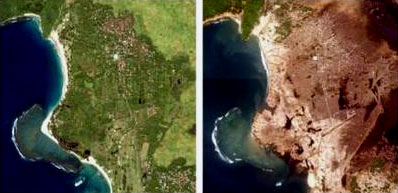
From green to brown -- the land is gutted
Aerial view of Banda Aceh, Sumatra, Indonesia.
Picture on left: January 10, 2004
Picture on right: December 29, 2004
(Three days after the tsunami)
Aerial view of Banda Aceh, Sumatra, Indonesia.
Picture on left: January 10, 2004
Picture on right: December 29, 2004
(Three days after the tsunami)
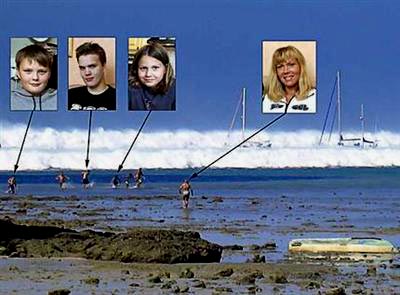
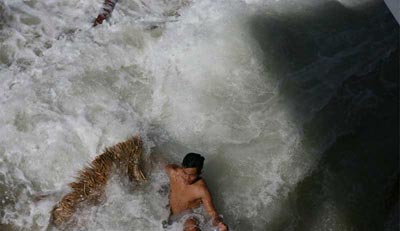
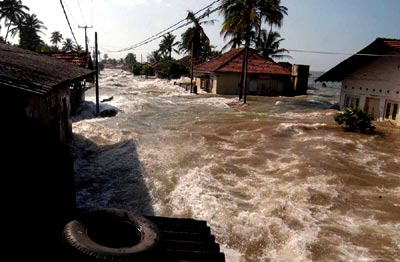
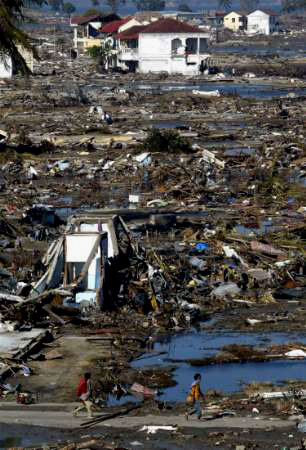
Destroyed houses from a tsunami in Banda Aceh, Sumatra, Indonesia
Assignment= Please click this website and watch the video @ what happens after an Earthquake on the bottom of the ocean causes a tsunami in Japan. Then describe what happens in your journal.
http://www.weather.com/outlook/videos/raw-tsunami-swamps-airport-19982#19988

Assignment= Please click this website and watch the animation @ what happens after an Earthquake on the bottom of the ocean. Then describe what happens in your journal.
Tsunami animation
Assignment= Please click this website and watch the animation @ what happens after an Earthquake on the bottom of the ocean. Then describe what happens in your journal.
Tsunami animation
Assignment= Please click this website and watch the animation @ what happens after an Earthquake on the bottom of the ocean. Then describe what happens in your journal.
The World Tsunami animation
On Line Assignment- Please look up on the internet about how a person can tell that a tsunami is about to happen. Fully explain the answer in your journal.
ASSIGNMENT=
Please copy these quizzes in your journal and fill in the blanks there
ASSIGNMENT=
Please copy these quizzes in your journal and fill in the blanks there
ASSIGNMENT=
Please copy these quizzes in your journal and fill in the blanks there
ASSIGNMENT=
ASSIGNMENT=
ASSIGNMENT=
Topic C. Plate Tectonics |
Indicator 1. Recognize and describe the internal and external structure of the Earth. |
Objective b. |
Selected Response Item | |||||||||||||||||||||||||||||||||||||||||||||||||||||||
|---|---|---|---|---|---|---|---|---|---|---|---|---|---|---|---|---|---|---|---|---|---|---|---|---|---|---|---|---|---|---|---|---|---|---|---|---|---|---|---|---|---|---|---|---|---|---|---|---|---|---|---|---|---|---|---|
Use the information below to answer the following. The Aleutian Trench is an underwater feature, near Alaska, formed by the movement of two tectonic plates. As the North American Plate moves toward the Pacific Plate, the lower edge of the Pacific Plate becomes part of the mantle.  The core of Earth is best described as
/toolkit/vsc/asse
sment_items/msa_scie | |||||||||||||||||||||||||||||||||||||||||||||||||||||||
POST TEST- Please answer these questions in your journal
§ What are the layers of the Earth?
§ What was Pangaea?
§ What is the Theory of Plate Tectonics?
§ What is the evidence for plate movement?
§ What causes plates to move?
§ What happens/forms when continental plates move?
§ What is an earthquake? How does is form?
§ What is a volcano? How does it form?
§ Why do earthquakes and volcanic eruptions occur?
Jeffrey S. Barker (SUNY Binghamton) Demonstrations of Geophysical Principles Applicable to the Properties and Processes of the Earth's Interior, NE Section GSA Meeting, Binghamton, NY, March 28-30, 1994.
Demo #6: Earthquake Machine
- Purpose:
- Demonstrates the principle of elastic rebound for the cause and recurrence of earthquakes.
- Supplies:
- Wood blocks, sandpaper, springs, weights (rocks), fishing reel (optional)
- Background and Demonstration:
- Under the Elastic Rebound Theory, the continuous motion of the Earth's plates causes stress to build up at the boundaries between the plates, where friction keeps the boundaries locked. Once the frictional stress (or the strength of the rocks) is exceeded, the two sides move (along a fault) causing an earthquake. This principal applies away from plate boundaries as well, since the locked plate boundaries causes the stress to extend to the plate interior. In this case, earthquakes occur anywhere the local strength of the rock is less than the regional stress level. The key point of the Elastic Rebound Theory is that the stress is continually building up, and that earthquakes act to relieve that stress. For a constant rate of stress increase due to plate motion, the greater the time between earthquakes, the greater the stress release when the earthquake occurs (larger magnitude).
 This experiment is based on a simple, yet elegant laboratory model suggested by Burridge and Knopoff in 1967, and is excellent for hands-on experiments by students. The two sides of a fault are represented by sandpaper-covered blocks resting on a sandpaper-covered board. A weight rests on the block (I use a rock) to apply a chosen amount of pressure on the sandpaper (defining the frictional strength of the fault). A spring is attached to the block and to a string, which is pulled by a fishing reel (or any other take-up device), by a weight suspended off the end of the board by a pulley, or by hand (although it is difficult to maintain a constant pull by hand). As the string is pulled, the spring is stretched, and the length of the spring is proportional to the shear stress applied to the block. When that stress becomes greater than the static frictional stress, the block slides relieving part of the stress, and shortening the spring. In theory for such a simple system, the block should stop when the shear stress equals the dynamic frictional stress, although partial stress-drop and friction overshoot have been interpreted for actual earthquakes. If you continue to pull on the string (either by turning the fishing reel or because the weight is still attached), the spring will continue to stretch until the static frictional stress is reached, and movement of the block will occur again. If this sequence is continued for several cycles, conclusions on earthquake recurrence (seismicity) may be drawn. There may be cases in which the local friction under the block is greater than usual, requiring more shear stress to accumulate before the block moves. By measuring the time between movements, the shear stress (the length of the spring), and the amount of motion of the block, it can be shown that small motions occur after short times and large motions occur after longer periods of "quiescence". Averages and standard deviations may be determined for the time between earthquakes and the amount of slip of earthquakes. Does this pattern change if the rate of stress accumulation is varied (turn the fishing reel faster or increase the suspended weight), or if the frictional stress is increased (add weight to the block)? Of course, faults are more complicated than a sandpaper-covered block. During an earthquake a length of fault (a segment) moves, but neighboring segments do not. We can simulate this effect by attaching another sandpaper-covered block with a spring to the first block. Now when the first block moves, it stretches the spring between the two blocks, causing a resisting stress on the first block (it doesn't move as far now), and increasing the shear stress on the second block. If you pull on the string for several cycles, an equilibrium will be established such that sometimes the first block moves (small earthquake), sometimes the second block moves (small earthquake) and sometimes both move simultaneously (large earthquake). Sometimes a large motion of one block or a simultaneous motion of both blocks will trigger a small motion after a relatively short time (an aftershock). The amount of motion and shear stress (length of the spring) for each block may be plotted through time. Also the amount of slip and time of occurrence of large and small "earthquakes" may be analyzed. The problem has now become quite complicated! Of course an even more complicated model can be tested by connecting three, four, or more sandpaper-covered blocks with springs and measuring the movement and shear stress on each.
This experiment is based on a simple, yet elegant laboratory model suggested by Burridge and Knopoff in 1967, and is excellent for hands-on experiments by students. The two sides of a fault are represented by sandpaper-covered blocks resting on a sandpaper-covered board. A weight rests on the block (I use a rock) to apply a chosen amount of pressure on the sandpaper (defining the frictional strength of the fault). A spring is attached to the block and to a string, which is pulled by a fishing reel (or any other take-up device), by a weight suspended off the end of the board by a pulley, or by hand (although it is difficult to maintain a constant pull by hand). As the string is pulled, the spring is stretched, and the length of the spring is proportional to the shear stress applied to the block. When that stress becomes greater than the static frictional stress, the block slides relieving part of the stress, and shortening the spring. In theory for such a simple system, the block should stop when the shear stress equals the dynamic frictional stress, although partial stress-drop and friction overshoot have been interpreted for actual earthquakes. If you continue to pull on the string (either by turning the fishing reel or because the weight is still attached), the spring will continue to stretch until the static frictional stress is reached, and movement of the block will occur again. If this sequence is continued for several cycles, conclusions on earthquake recurrence (seismicity) may be drawn. There may be cases in which the local friction under the block is greater than usual, requiring more shear stress to accumulate before the block moves. By measuring the time between movements, the shear stress (the length of the spring), and the amount of motion of the block, it can be shown that small motions occur after short times and large motions occur after longer periods of "quiescence". Averages and standard deviations may be determined for the time between earthquakes and the amount of slip of earthquakes. Does this pattern change if the rate of stress accumulation is varied (turn the fishing reel faster or increase the suspended weight), or if the frictional stress is increased (add weight to the block)? Of course, faults are more complicated than a sandpaper-covered block. During an earthquake a length of fault (a segment) moves, but neighboring segments do not. We can simulate this effect by attaching another sandpaper-covered block with a spring to the first block. Now when the first block moves, it stretches the spring between the two blocks, causing a resisting stress on the first block (it doesn't move as far now), and increasing the shear stress on the second block. If you pull on the string for several cycles, an equilibrium will be established such that sometimes the first block moves (small earthquake), sometimes the second block moves (small earthquake) and sometimes both move simultaneously (large earthquake). Sometimes a large motion of one block or a simultaneous motion of both blocks will trigger a small motion after a relatively short time (an aftershock). The amount of motion and shear stress (length of the spring) for each block may be plotted through time. Also the amount of slip and time of occurrence of large and small "earthquakes" may be analyzed. The problem has now become quite complicated! Of course an even more complicated model can be tested by connecting three, four, or more sandpaper-covered blocks with springs and measuring the movement and shear stress on each. - Reference:
- R. Burridge and L. Knopoff, "Model of Theoretical Seismicity", Bulletin of the Seismological Society of America, 57: 341-371, 1967.
Jeffrey S. Barker (SUNY Binghamton) Demonstrations of Geophysical Principles Applicable to the Properties and Processes of the Earth's Interior, NE Section GSA Meeting, Binghamton, NY, March 28-30, 1994.

































